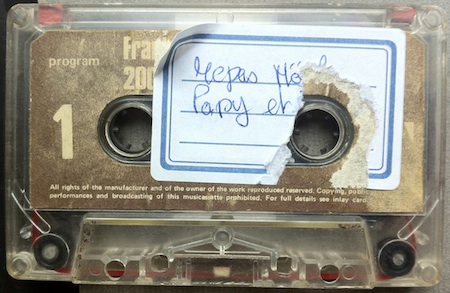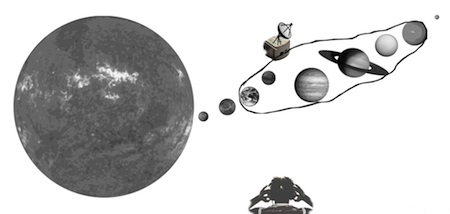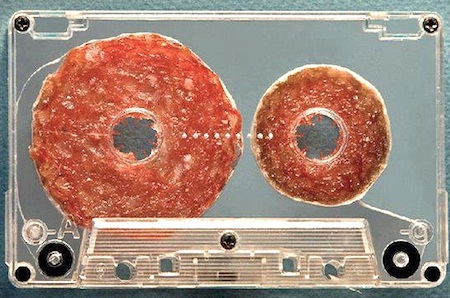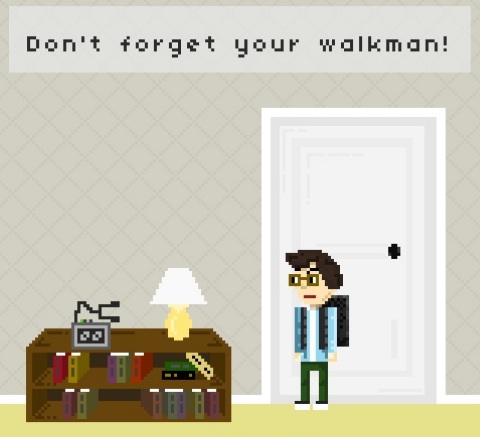
Follow Lang Leve Lou Ottens! on Tumblr!
14 min read 🤓
The Art of K7 (prelude)
[sketch/book, 1]
octobrrrre 25, 2013.
[ Summary: ]
... - ... - About the some things that are certain - Papier Machine, Derrida and other toxic byproducts - All the way to Neptune and back (that makes 8 light hours) - On Re/Vival - Just to justify (many, many, many a 1000 more words) - The cassetteer and the DJ - It's a poor man's thang - Why to love retro-chic poppers and hipsters - Did I say there is no Hell? - Audio slates - Frank Zappa's '200 Motels' and a Christmas dinner at granny's - Not a one but a many - "Unto emptiness shalt thou return" - ... - ...
This much is certain: the fiftieth anniversary of the audio compact cassette did not go unnoticed.
Many a mainstream medium jumped at the occasion, and shone its light on the demise and current re-vival of the small rectangular plastic boxes with sounds 'etched' upon plastic ribbons wound around small plastic wheels.
There were sóóó many articles that at some point I lost track.
(Insert remark ☞ on the equivalence - metaphorical - of magnetic audio tape with the ribbon of a typewriter; all typed text, in a very literal way, got recorded onto a type writer's ribbon; this was particularly striking in the case of professional electric writing machines like those manufactured by IBM; ) many of these used plastic carbon film ribbons held within a cassette, that was 'played' only once, from beginning to end; the IBM type writer's cassette recorded every single symbol that was typed, and it was pretty easy afterwards to reconstitute the written text from the ribbon, on which the typed characters could be seen as light outlines against the dark ribbon background. When Philips presented Lou Ottens's tape to the world, the typewriter of course still was the predominant mechanical writing tool. I, for one, only *really* began to use text editing software on the computer towards the end of the 1980s; all of this then of course reminds one of Papier Machine, a collection of Jacques Derrida's prose poems [tongue-in-cheek; take this as a joke] that I only read a handful of years ago but whose title can not but be not related to Presse Papier, the unorthodox name of my late 1970's unorthodox Amsterdam popband.
many of these used plastic carbon film ribbons held within a cassette, that was 'played' only once, from beginning to end; the IBM type writer's cassette recorded every single symbol that was typed, and it was pretty easy afterwards to reconstitute the written text from the ribbon, on which the typed characters could be seen as light outlines against the dark ribbon background. When Philips presented Lou Ottens's tape to the world, the typewriter of course still was the predominant mechanical writing tool. I, for one, only *really* began to use text editing software on the computer towards the end of the 1980s; all of this then of course reminds one of Papier Machine, a collection of Jacques Derrida's prose poems [tongue-in-cheek; take this as a joke] that I only read a handful of years ago but whose title can not but be not related to Presse Papier, the unorthodox name of my late 1970's unorthodox Amsterdam popband.
[ Most tapes in cassettes - if unwound - will be about 86 (C60) or 130 (C90) meters long; onto one side a magnetic emulsion has been glued, which often - because of its audio quality enhancing properties - contains chromium dioxide, the mass production of which "yielded toxic by-products of which Japanese manufacturers had great difficulty properly disposing". ( * ) ]
Re-vival, of course, is relative.
...
Ever since its introduction on the audio consumer market, artists have been using cassette tapes and cassette recorders; in several ways. As part, but also at the very heart, of their work. In the early days: think of the mail art movement; in the middle days (seventies, eighties, nineties) other creative possibilities of the format gradually got uncovered; in performances and installations cassettes e.g. were used as loop devices; cassette recorders were used as ad hoc sound sampling machines. In the format's late days and in its aftermath, starting in the very late nineties and lasting until today, we saw the number of musicians and improvisers that made cassette tapes the sound sources and cassette recorders the instruments of their choice growing fast.
Like the DJ musician who uses and misuses vinyl records and gramophones to great musical avail in performances and in recordings, the cassetteur (cassetteer) sets about using, treating and maltreating his/her tapes, dictaphones and other tape playing devices. About a decade ago, cassetteurs were still relatively rare. But with cassettes being replaced at lightning speed by digital formats and the walkman by the iPod, ever more performers (young and old, not only but often of a self-declared 'experimental', 'avant-garde' or 'huh, music?' kind) can be seen and heard manipulating tapes and dictaphones. Not in the least because of the thousands of tapes and the many hundreds of playback/recording devices that these past ten years anyone could pick up for free from amidst the household garbage put out in the street, or for near to nothing at garage sales and on flea markets. Cassetteers are popping up here, there and everywhere; still mainly in fringe settings, though slowly also more mainstream academic and gallery-art spots seem to be catching up with K7 'experimentation'.
The list of artists that participated in one or more editions of Tales for Tapes (a series of live events around tapes and their manipulations curated since December 2009 by Rinus van Alebeek and Anton Mobin) is but the tip of an iceberg. Be it a relatively small one, the iceberg became the source of an interesting corpus of work. Music and sound 'with an attitude'. A 'genre' (and I do think there is ample reason to consider it as such) that stylistically lives somewhere in the vacant lots and borderlands between contemporary indie (noise-)rock and free improvisation, while conceptually leaning heavily - though in many cases unconsciously - on late 20th century academic electronic (tape) music and 'free art movements' from around the same time (especially Fluxus), and especially blooming in socio-economic contexts with a strong anti-consumerist tendency. Together these characteristics account for the genre's objective and demonstrable artistic and musical traditionalism. And again: that's a mighty interesting trait, as it diametrically opposes the generally perceived 'experimentalism' and 'vanguardism' of its practitioners (though arguably more by others than by themselves ...)
Some two years ago I received a review copy of MIT Press's beautiful hard cover edition of Caleb Kelly's PhD thesis on the creative abuse of (physical) sound carriers and sound players, Cracked Media: The Sound of Malfunction.
I was happy to be given the opportunity to read that book, which deals with an essential chapter in the recent history of { music slash technology }. A chapter also that is quickly nearing its historical end, as it is more than likely that with the CD the history of physical sound carriers has come to a halt. Caleb's treatment of the cases of vinyl record & gramophone player and that of compact disc & CD player is exemplary. But apart from a description of Nam June Paik's Random Access Music from 1963, he completely ignores the creative abuse of magnetic tape (reel-to-reel and cassette) and the cracking of (cassette) tape recorders and players.
Caleb explains (on page 25) that for his research he did not consider tapes and tape machines because "the cracking and breaking of tape technologies was not a significant and sustained practice. Tape technologies were used as an important form of composition in the second half of the twentieth century, but for the most part this was achieved through the legitimate practices of editing and the extended practices of looping."
We might argue whether it was or was not; but there is no doubt that currently tape-cracking is a significant and sustained artistic and musical practice. Just the other day I finally wrote my review/essay on (or rather: around) Cracked Media. In Dutch. The article is to appear in the upcoming 118th issue of Gonzo (circus). One of that article's upshots is that it was the omission in Caleb's book that incited me to seriously take up the writing of The Art of the K7, tentative title (with a nod to Johann Sebastian) for a book that is to deal extensively with the wealth of tape based (fringe) music that has seen the light over the past, say, fifteen years. It will be a subjective, personal history; it will be an eulogy but also a musical and artistic critique. It will contain an exhaustive description of all the possible (and many impossible) playing and performance techniques for cassettes and cassette machines. It will make you discover & hear things that even in your wildest dreams you could not have imagined. It will contain gossip. It will contain anecdotes. It will contain stories. It will also, and not in the least, thoroughly investigate the socio-economic context that, for example, until this very day brands cassettes and cassette machines as a "poor man's thang". This, I will argue, is a main reason for the fact that, contrary to vinyl records/gramophones and CD's/CD-players, it has taken such a while before (cracked) cassettes and cassette players started to pop up in works created explicitly in the context of gallery and academic art. Which in turn of course is the real reason why there's no tape in Caleb Kelly's book, and why, until this very day, much of the best cassette(tape) based music is made by cassette(e)(u)rs that largely operate outside the academic and gallery art circuits.
(Parts of the content of this and other, related, blog entries, are intended as sketches that may or may not, in some form or other, eventually, become part of The Art of the K7.)
Here's another certainty, and we all know it. The cassette, like the vinyl platter, is no longer a means for music mass consumption. The days that pop music hit-albums sold many millions not only on vinyl, but also in the pre-recorded cassette format (as well as being illegally copied onto blank cassette tapes another many, many million more times) will not come back.
This fact notwithstanding, in the mere fifty years of its existence, our world was flooded with cassettes. The quantity of compact cassettes produced world wide in the five decades since its introduction according to an authoritative estimation is said to have been roughly between the 50 and 100 billion (= 1011): that makes an estimated average of more than ten cassette tapes, or more than ten hours of recorded sound and music, for every single human being alive. If, for argument's sake, we stick to the max, and assume, for simplicity's sake, that all of them were C60's, then we could've spliced the past 50 years of cassette tape into one meta-mega tape, measuring 8.55 billion kilometers.
It would take, ladies and gentlemen readers, a spark of light - almost - 8 hours to travel from one end to the other; we could - almost - stretch this meta-tape all the way from here to Neptune and back again; playing it would take about 11.4 million years: if we hit play now, the meta-cassette's playback will not stop before the time that the ring of debris around Mars has crashed upon the surface of that very planet. And then finally imagine: almost all of the music we'd hear coming from our meta-tape would be that of a mindboggling number of copies of Michael Jackson albums and similar top selling pop chart hits, endlessly repeating ... So, did I say there is no Hell? ... ![]() ... ( ** )
... ( ** )
The current & much publicized world wide nostalgia and retro-chic driven vintage and vanity cassette album production, by a jolly bunch of alternative poppers, indie-rockers, sweet hipsters and, also, by a number of less-fringe acts that - most of them for retro and nostalgia's sakes - want to be in on the trend as well -- (now don't get me wrong: I love them all! I love them for noppers and for having their fun; and I dearly hope they'll persist; in having their fun, I mean) -- will only add digits to the far, far right end of this astronomical number. Which means that, essentially, in the near and far future this number is unlikely to change by very much.
How many of these billions of tapes ended up in the streets, in landfills and other garbage repositories? (Yes, I am a specialist! Insert some lines ☞ on the infamous Found Tapes Exhibition...) My gut estimation: half of them. The bulk of the remaining half consists in the tapes that are kept, unused, in closets, cellars and attics, but that will surely 'end up in the gutter' within the next couple of decades or so. Is it possible to imagine the sheer volume, the quantity of this waste? ( *** )
It were these and such things that over the summer months often crossed my mind, sleepily dreaming on my solitary stretch of Ré-beach, where I was trying to boost my somewhat ailing health.
Lou Ottens never strayed very far...

In its heydays, also the average household user considered cassettes to be audio slates. They were erasable. They were transparent. An audio cassette served multiple purposes. One could replace their content over and over again. Everybody knew how to erase and re-record a pre-recorded tape by covering its write protection notches with a little piece of Scotch. Have a peek at the cassette in the picture above. It's an item that I recently picked up from the pavement not far from where I live. As witnessed by its labels, this leftover from a garage sale originally was a copy of a United Artists cassette album release of the soundtrack to Frank Zappa's masterly but still largely underrated 200 Motels. Finding an original cassette copy of whatever Zappa album would be something to rejoice in. But all of the Zappa music that the tape once contained had been erased. It was replaced by an impromptu collage of bits and pieces of main stream rock music recorded from French public radio. Which then in turn - somewhere towards the end of the tape's second side and as witnessed by the sticker the tape's previous owner stuck onto it (the handwriting is feminine; the sticker's presence indicates that the recording must have been of some sort of special interest to her; it reads "Repas Noël Papy et Mamy") had given way to a microphone recording apparently made during a Christmas dinner at someone's grandparents' place.
"I guess it is no wonder," my thoughts went and wandered, "that the cassette invokes a sense of nostalgia that is so much stronger than the one brought on by the vinyl record. Never mind the technical superiority of the vinyl as a sound carrier; never mind the esthetic superiority of its perfectly round ribbled flatness; of the so very simple geometry and fine topology, which is the same as that of a donut. Other than scratching it, carving your name and a heart into it with a Swiss knife, as if it were the trunk of tree, cutting, breaking or melting it, there is little that you can do to make a piece of vinyl 'your own'."
"The sounding spiral that it keeps is immutable," the ocean's waves whispered.
"It is that Edison had not yet invented the gramophone," I soflty sang back to them. "God would surely have preferred recording a vinyl record over cutting his words into stone..."
With a cassette tape things are different.
Whether pre-recorded or not, at heart the cassette is and remains an empty container that can be filled with whatever you want. And cassettes are deconstructable. You can take them apart and put them back together again.
Unlike a vinyl record, a cassette - and the French have just the right word for it - is a machin, with many distinct components. It is not a one, it is a many. And merely one among these many is the actually sound carrier.
It comes with a geometry and topology that is nothing like that of the vinyl record.
The magnetic tape is a line; it is a very long and thin plastic thread wound around a plastic wheel. It is an unreservedly modifiable, malleable and flexible - because essentially empty - space. It is crosslinkable, cuttable, inversible, knottable. Its malleability is the reason that so many people love the cassette. They remember the many ways in which they used it. And there were these many ways to use it, because it came to them, essentially, as a blank. It made the cassette a perfect canvas for your memories: given any single one of the 100 billion audio compact cassettes that over these past fifty years have been made, nothingness lies just around the corner...
"For empty thou art and unto emptiness shalt thou return." ( **** )
- Read more on the Art of K7 :: Sudokaising -
notes __ ::
(*) Source for this: Wikipedia entry on chromium dioxide, retrieved September 23rd, 2013. [
^ ]
(**) For more, utterly useless but fun, cassette volume calculations, see the second part of
the SoundBlog's Back to Berlin (2007) series, and some recent SoundBlog tweets. That the ring of debris around Mars will hit the surface of that planet in about 11 million years, is one of the far future facts that can be found on Wikipedia (retrieved September 23rd 2013) [
^ ]
(***) This is of course not typical for the audio cassette. [
^ ]
(****) Cf. Genesis 3:19. [ ^ ]
Read all about Found Tapes, Foundtaping and Audio Cassettes (K7s) on the SoundBlog:
(2023, september 21) - Holland[s] Spoor
(2022, january 11) - 'The Art of K7', vol. 1
(2021, september 11) - The Art of K7 :: Sudokaising [ii] Time Folds
(2020, march 21) - The Art of K7 :: Sudokaising [i]
(2019, november 17) - Foundtapers & Foundtaping in Porto
(2019, februay 08) - CCNL :: Cassette Culture in Linz, Austria
[ii] The aesthetics of erasure
(2019, januay 18) - CCNL :: Cassette Culture in Linz, Austria
[i] Oral history
(2015, november 22) - Situasonnisme: the City Sonic Festival
(2014, june 19) - Lecture de Cassette
(2013, october 25) - The Art of K7 (prelude) [sketch/book, 1]
(2013, march 23) - "Ma première cassette était vierge..." Mourning & celebrating 50 years of compact cassette
(2012, july 26) - UnOfficial Release
(2010, november 28) - Foundtaping, Maps & Shadows
at the Basel Shift Festival (i.)
(2009, november 15) - prof. dr. Cassette
(2009, november 08) - A found tapes meta-map
(2009, october 22) - Founded Tapapes
(2009, september 20) - Found Lost Sound
(2009, july 26) - "You, a bed, the sea ..." [ 1. Athens, sept. 28th 1994 ]
(2009, may 23) - It feels like summer in the city [KT2009, i]
(2009, february 19) - Time and the weather - "? Footage or Fetish" @ Käämer 12, Brussels (ii)
(2009, january 30) - A Tingel Tangle Tape Machine - "? Footage or Fetish" @ Käämer 12, Brussels (i)
(2009, january 15) - Kassettenkopf
(2008, december 08) - un-Tuned City (foundtaping in Neukölln)
(2008, september 14) - Psycho/Geo/Conflux in Brooklyn, NY __i.
(2008, august 31) - " Le chasseur " (foundtaping in brussels_ii)
(2008, june 18) - "Sing Laping, Sing !" (foundtaping in brussels_ i)
(2008, january 06) - Mo' Better Mo-Tapemosphere, 2. Restmuell
(2007, june 16) - Mo' Better Mo-Tapemosphere, 1. "chase away all my fear"
(2007, march 07) - Back to Berlin 2. Found Tapes
(2006, september 28) - jenny likes poets
(2006, september 06) - the sound of almost-no-more words
(2006, june 13) - fotex #49-51
(2006, june 04) - Sonofakunsttoer
(2006, april 17-25) - 'sudoku-solution' in 'de nor'
(2006, january 19) - ride, buggy, ride ... !
(2006, january 13) - axiologie for dummies
(2005, november 06) - found in maastricht
(2005, august 28) - tête-de-tettine / tête-de-cassette
(2005, august 23) - tape busters and coordinates
(2005, july 02) - Conquering America ...
(2005, june 03) - stationed soother
(2005, april 21) - Low-fi : the new Readymades
(2005, march 24) - d_Revolution #1 ...
(2005, february 07) - found tapes for spies
(2005, january 28) - "parfois l'amour tourne à l'obsession ..."
(2004, november 06) - à la tranquilité
(2004, july 20) - instructions in arabic
(2004, may 08) - phound stufphs
(2003, august 04) - new acquisitions #7, #8
(2003, may 04) - r2r
(2003, april 24) - splice and tape
(2003, april 15) - new acquisitions #5,#6
(2003, january 09) - finders keepers
(2002, november 24) - exhibit #4
(2002, november 08) - what fascinates me
(2002, november 07) - more on found tape montage
(2002, september 14) - detour
(2002, september 09) - 2 down, 3 to go
(2002, september 06) - magnetic migration
Read about Found Tapes in Gonzo (Circus) [Dutch]:
Gonzo #163, mei/juni 2021 - Lang Leve Lou Ottens
Gonzo #137, januari/februari 2017 - Het Kaf en het Koren
tags: cassette
# .444.
comments for The Art of the K7 (prelude) ::
|
Comments are disabled |




